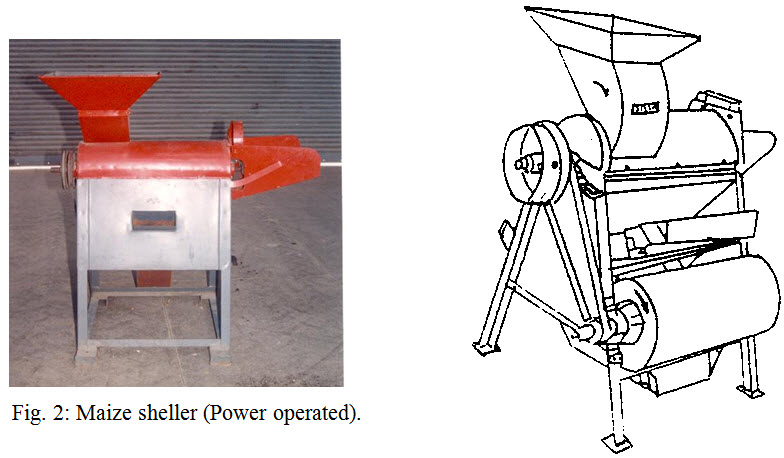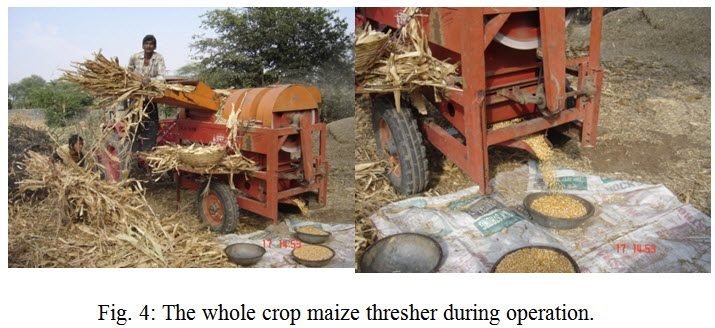Site pages
Current course
Participants
General
MODULE 1. PRINCIPLES AND TYPES OF CUTTING MECHANISM
MODULE 2. CONSTRUCTION AND ADJUSTMENT OF SHEAR AND...
MODULE 3. CROP HARVESTING MACHINERY
MODULE 4. FORAGE HARVESTING, CHOPPING AND HANLING ...
MODULE 5. THRESHING MECHANICS, TYPES OF THRESHES, ...
MODULE 6. MAIZE HARVESTING AND SHELLING EQUIPMENT
MODULE 7. ROOT CROP HARVESTING EQUIPMENT
MODULE 8. COTTON PICKING AND SUGARCANE HARVESTING ...
MODULE 9. PRINCIPLES OF FRUIT HARVESTING TOOLS AND...
MODULE 10. HORTICULTURAL TOOLS AND GADGETS
LESSON 14. MAIZE SHELLER: TYPES, COMPONENTS AND WORKING PRINCIPLES
Harvesting and de-husking of corn (maize) is done manually. De-husking of maize cobs is necessary for use on shellers. Octagonal hand maize sheller (Fin type) is used for shelling of dehusked maize cobs, especially for seed purposes. It is manually operated (Fig. 1). It is a manually operated simple device to remove maize grains from the dehusked cobs. The sheller is of octagonal shape. The sheller consists of 4 mild steel fins tapered along their length, one edge of the fin is taper. In each fin, two holes are provided for riveting. Each fin is bent at two places in a manner for assembling in octagonal shape. The corners of the fins are rounded in order to avoid injury to the operator during shelling operation. The fins are joined together with rivets. The assembled sheller has thus four tapered projections inside the sheller body that accomplishes removal of the grain from the maize cob. In order to avoid corrosion, the sheller is powder coated which also increases its working life. For operation, the sheller is held in left hand and the dehusked maize cob in right hand (for right hand person). The cob is inserted in the sheller and is given forward and backward twist or given clockwise and anticlockwise strokes repeatedly. The tapered edges of the fins dig into the space between the rows of the grains in the cob and with the forward or backward stroke the grains are released from the cob. After grains are separated from one end of cob, the other end is inserted in the sheller to complete the removal of grains from cob. Due to the taper edges of the fins, which are projected inside the sheller body, one end of the sheller has larger opening and the other smaller. Therefore, for shelling the larger end of the cob it is inserted in the larger opening of the sheller and the smaller opening of the sheller is used for smaller end of the cob. Working capacity maize sheller is 15 to 20 kg/h and weight of the machine is 0.22 kg.

Maize sheller (Power operated)
Maize Sheller is used to separate grain from cobs. Before shelling, the foliage is removed manually. Maize shellers are either manually operated or power operated. A power operated maize Sheller uses 30-36 cm diameter cylinder of 80-100 cm lengths (Fig. 2). On the periphery of the cylinder, there are pegs that remove the grain from cobs using axial flow movement. The cylinder speed is maintained in between 500-600 rpm. The cob moves toward the end of sheller from feeding side and during this process grains are rubbed against drum and posses through the concave. Blower is provided to remove lighter material. Concave clearance and cylinder speed can vary and adjusted as per recommendation.
Maize shellers are used for all types of maize varieties local as well as hybrid and composites. Maize shellers are of two types’ viz. spring type and cylinder type. Spring-type sheller consists a rotating fluted cylinder, a rotating disc and a spring pressure plate. The cobs are fed to rotating fluted cylinder and kernels are removed from cobs as they move in between cylinder and disc. Blower blow off the light material and clean grain is collected separately. These shellers are available in various sizes such as domestic shellers, single-hole and double-hole shellers. Domestic sheller is a hand operated and available with small farmer for shelling of small quantity of maize.
The cylinder-type sheller consists of a cylinder with lugs, concave assembly and a blower unit. Spiral ribs are provided in the cylinder for smooth movement of cobs. Cobs are fed in between cylinder and concave and kernels are removed by the action of lugs. Blower cleans the lighter materials and small pieces of cobs and clean grain is collected. The 5-10 hp electric motor or tractor can operate the machine. It can give output of 5-15 q/h depending upon the size of power sources and machine. Overall dimensions are:
|
Size of feeding hopper, mm |
575x510 |
|
Length of drum, mm |
890 |
|
Dia of drum, mm |
305 |
|
Concave opening size, mm |
11 |
|
Cylinder concave clearance, cm |
1.6 |
|
Pulley size, mm |
400 |
Other features of machine are:
|
Peripheral cylinder speed, m/s |
11.2 |
|
Labour requirement to work on the machine |
two |
|
Blower speed, rpm |
890 |
|
Straw grain ratio |
5:1 |
|
Average feed rate, q/h |
25 |
|
Average grain output, q/h |
20 |
|
Grain losses, % |
less than 1 |
|
Cleaning efficiency, % |
more than 99 |
|
Threshing efficiency, % |
more than 99 |
|
Grain crack age, % |
0.5-1.0 |

Maize dehusker-sheller
The department of Farm Power & Machinery, PAU Ludhiana has developed two types of Maize dehusker cum threshers namely spike tooth type (modified version of wheat thresher) and axial flow type (modified version of sunflower thresher) for threshing the maize along with the husk. It is used for dehusking and shelling of maize cobs simultaneously. It is operated by a PTO of 26.1 kW tractors (Fig. 3). In the spike tooth type sheller, pegs are staggered at varying heights for better shelling efficiency. The spikes are placed in 6 rows with 6 pikes in each row. The sieves have 1.25 cm diameter opening to separate the shelled maize from husk. In axial flow type threshers, pegs are provided on the cylinder and louvers were provided on the upper periphery of the drum to convey the crop to the outlet. Working capacity of sheller is 15-20 q/h. Weight of the machine is about 600-700 kg. Shelling efficiency is about 100% in both the cases and broken grains are maximum up to 2.0%. Dehusking-cum-shelling saves lot of labour in comparison to traditional system. Performance results of the machine are given below.
|
S. No. |
Parameter |
Observations |
|
|
2 |
Grain straw ratio |
4.2 |
|
|
3 |
M.C. of grain, % |
12.1-18.5 |
|
|
4 |
Cylinder speed, rpm |
670-750 |
|
|
5 |
Broken grain (%) |
1-3 |
|
|
6 |
Un-threshed grain (%) |
0.74 |
|
|
7 |
Threshing efficiency (%) |
98-99.5 |
|
|
8 |
Cleaning efficiency (%) |
90-95 |
|
|
9 |
Grain output capacity, q/h |
4.5-6.5 |
|
|
10 |
Blown kernal, % |
1-3 |
|
|
11 |
Labour requirement, man-h/ha |
5 |
|
|
12 |
Labour saving in comparison to traditional shelling, % |
50-60 |

Whole crop maize thresher
A whole crop maize thresher (Fig. 4) has been developed at MPUAT Udaipur with the objectives to do the shelling of maize cob and simultaneously stalk is converted to chaff. A tractor operated multi crop thresher was also modified with arrangement so of spikes on threshing cylinder and concave made of 8 mm square bar with 19 mm spacing. The output of grain was observed as 710 kg/h with chaff size of 16 to 63 mm. This chaff was fed to the animals and 85% material was consumed in comparison to the whole stalk. The significant saving in labour was found for detachment of cobs and transportation of crop from field to home. The threshing efficiency was 99% and cleaning efficiency 96.4%.

Tractor-drawn combines with suitable adjustment can be used for de-husking and shelling of maize in stationary operation. The following adjustments can be made in the combine before using for maize shelling:
(i) The drive to cutter bar should be disconnected and reel removed for easy feeding of maize ears.
(ii) Rasp bar cylinder used for wheat threshing should be used for maize threshing. The speed of the cylinder may be kept between 500-600 rpm as compared to 900 rpm for wheat.
(iii) Cylinder-concave clearance should be around 25 mm for maize threshing.
(iv) The sieve in the cleaning shoe should be replaced by large size hole (approximately 12.5 mm).
(v) If the combine does not have a grain tank, grain should be collected directly from the chaffer to avoid grain damage. However, if the grain tank is provided no such change is necessary.
(vi) There should be at least two canvas screens on the straw rack/walkers. One screen is normally provided at one-third distance in the first portion. The second screen should be provided at one-third distance from the rear. This is necessary to avoid grain losses.
The combine, if modified as above, can be used for de-husking and shelling of maize cobs satisfactorily at cylinder speed of 575 rpm and cylinder-concave clearance of 20 mm. The capacity of machine ranges between 2.0-2.5 t/h at a feed rate of 3.0-3.5 t/h. Cylinder and shoe (including rack) losses are 1.5% each and grain crackage about 2%.